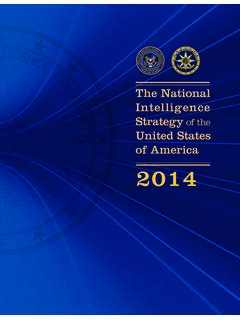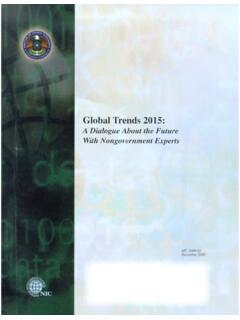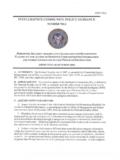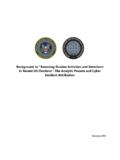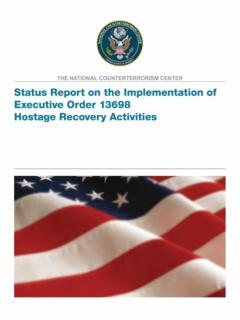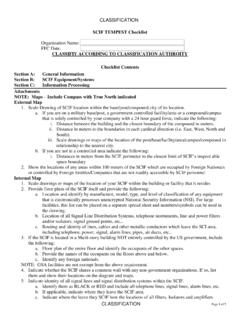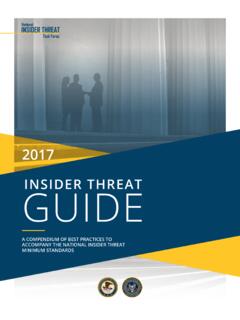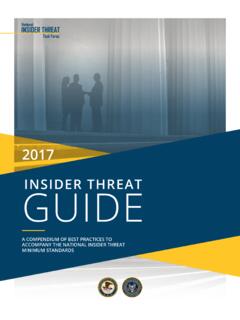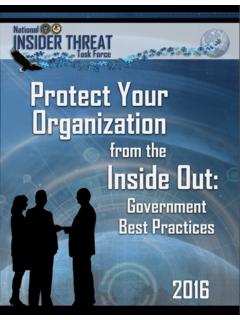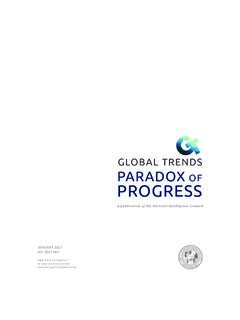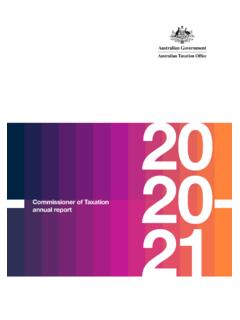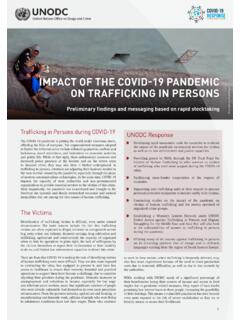Transcription of 29 JANUARY 2019 - dni.gov
1 Senate Select Committee on Intelligence 29 JANUARY 2019. STATEMENT FOR THE RECORD. WORLDWIDE THREAT ASSESSMENT. of the US INTELLIGENCE COMMUNITY. JANUARY 29, 2019. INTRODUCTION. Chairman Burr, Vice Chairman Warner, Members of the Committee, thank you for the invitation to offer the United States Intelligence Community's 2019 assessment of threats to US national security. My statement reflects the collective insights of the Intelligence Community's extraordinary women and men, whom I am privileged and honored to lead. We in the Intelligence Community are committed every day to providing the nuanced, independent, and unvarnished intelligence that policymakers, warfighters, and domestic law enforcement personnel need to protect American lives and America's interests anywhere in the world. The order of the topics presented in this statement does not necessarily indicate the relative importance or magnitude of the threat in the view of the Intelligence Community.
2 Information available as of 17 JANUARY 2019 was used in the preparation of this assessment. ATTENTION: This product contains US persons information, which has been included consistent with applicable laws, directives, and policies. Handle in accordance with recipient's intelligence oversight and/or information handling procedures. CONTENTS. INTRODUCTION .. 2. CONTENTS .. 3. FOREWORD .. 4. GLOBAL THREATS .. 5. 5. ONLINE INFLUENCE OPERATIONS AND ELECTION INTERFERENCE .. 7. WEAPONS OF MASS DESTRUCTION AND 8. TERRORISM .. 10. COUNTERINTELLIGENCE .. 13. EMERGING AND DISRUPTIVE TECHNOLOGIES AND THREATS TO. ECONOMICCOMPETITIVENESS .. 15. SPACE AND COUNTERSPACE .. 16. TRANSNATIONAL ORGANIZED CRIME .. 18. ECONOMICS AND ENERGY .. 19. HUMAN SECURITY .. 21. REGIONAL 24. CHINA AND RUSSIA .. 24. EAST ASIA .. 24. MIDDLE EAST AND NORTH AFRICA.
3 29. SOUTH 35. RUSSIA AND EURASIA .. 36. EUROPE .. 38. AFRICA .. 39. THE WESTERN 40. FOREWORD. Threats to US national security will expand and diversify in the coming year, driven in part by China and Russia as they respectively compete more intensely with the United States and its traditional allies and partners. This competition cuts across all domains, involves a race for technological and military superiority, and is increasingly about values. Russia and China seek to shape the international system and regional security dynamics and exert influence over the politics and economies of states in all regions of the world and especially in their respective backyards. China and Russia are more aligned than at any point since the mid-1950s, and the relationship is likely to strengthen in the coming year as some of their interests and threat perceptions converge, particularly regarding perceived US unilateralism and interventionism and Western promotion of democratic values and human rights.
4 As China and Russia seek to expand their global influence, they are eroding once well- established security norms and increasing the risk of regional conflicts, particularly in the Middle East and East Asia. At the same time, some US allies and partners are seeking greater independence from Washington in response to their perceptions of changing US policies on security and trade and are becoming more open to new bilateral and multilateral partnerships. The post-World War II international system is coming under increasing strain amid continuing cyber and WMD proliferation threats, competition in space, and regional conflicts. Among the disturbing trends are hostile states and actors' intensifying online efforts to influence and interfere with elections here and abroad and their use of chemical weapons. Terrorism too will continue to be a top threat to US and partner interests worldwide, particularly in Sub-Saharan Africa, the Middle East, South Asia, and Southeast Asia.
5 The development and application of new technologies will introduce both risks and opportunities, and the US economy will be challenged by slower global economic growth and growing threats to US economic competitiveness. Migration is likely to continue to fuel social and interstate tensions globally, while drugs and transnational organized crime take a toll on US public health and safety. Political turbulence is rising in many regions as governance erodes and states confront growing public health and environmental threats. Issues as diverse as Iran's adversarial behavior, deepening turbulence in Afghanistan, and the rise of nationalism in Europe all will stoke tensions. 4. GLOBAL THREATS. CYBER. Our adversaries and strategic competitors will increasingly use cyber capabilities including cyber espionage, attack, and influence to seek political, economic, and military advantage over the United States and its allies and partners.
6 China, Russia, Iran, and North Korea increasingly use cyber operations to threaten both minds and machines in an expanding number of ways to steal information, to influence our citizens, or to disrupt critical infrastructure. At present, China and Russia pose the greatest espionage and cyber attack threats, but we anticipate that all our adversaries and strategic competitors will increasingly build and integrate cyber espionage, attack, and influence capabilities into their efforts to influence US policies and advance their own national security interests. In the last decade, our adversaries and strategic competitors have developed and experimented with a growing capability to shape and alter the information and systems on which we rely. For years, they have conducted cyber espionage to collect intelligence and targeted our critical infrastructure to hold it at risk.
7 They are now becoming more adept at using social media to alter how we think, behave, and decide. As we connect and integrate billions of new digital devices into our lives and business processes, adversaries and strategic competitors almost certainly will gain greater insight into and access to our protected information. China China presents a persistent cyber espionage threat and a growing attack threat to our core military and critical infrastructure systems. China remains the most active strategic competitor responsible for cyber espionage against the US Government, corporations, and allies. It is improving its cyber attack capabilities and altering information online, shaping Chinese views and potentially the views of US citizens an issue we discuss in greater detail in the Online Influence Operations and Election Interference section of this report.
8 Beijing will authorize cyber espionage against key US technology sectors when doing so addresses a significant national security or economic goal not achievable through other means. We are also concerned about the potential for Chinese intelligence and security services to use Chinese information technology firms as routine and systemic espionage platforms against the United States and allies. China has the ability to launch cyber attacks that cause localized, temporary disruptive effects on critical infrastructure such as disruption of a natural gas pipeline for days to weeks in the United States. Russia We assess that Russia poses a cyber espionage, influence, and attack threat to the United States and our allies. Moscow continues to be a highly capable and effective adversary, integrating cyber espionage, attack, and influence operations to achieve its political and military objectives.
9 Moscow is now staging cyber attack assets to allow it to disrupt or damage US civilian and military infrastructure during a crisis and poses a significant cyber influence threat an issue discussed in the Online Influence Operations and Election Interference section of this report. 5. Russian intelligence and security services will continue targeting US information systems, as well as the networks of our NATO and Five Eyes partners, for technical information, military plans, and insight into our governments' policies. Russia has the ability to execute cyber attacks in the United States that generate localized, temporary disruptive effects on critical infrastructure such as disrupting an electrical distribution network for at least a few hours similar to those demonstrated in Ukraine in 2015. and 2016. Moscow is mapping our critical infrastructure with the long-term goal of being able to cause substantial damage.
10 Iran Iran continues to present a cyber espionage and attack threat. Iran uses increasingly sophisticated cyber techniques to conduct espionage; it is also attempting to deploy cyber attack capabilities that would enable attacks against critical infrastructure in the United States and allied countries. Tehran also uses social media platforms to target US and allied audiences, an issue discussed in the Online Influence Operations and Election Interference section of this report. Iranian cyber actors are targeting US Government officials, government organizations, and companies to gain intelligence and position themselves for future cyber operations. Iran has been preparing for cyber attacks against the United States and our allies. It is capable of causing localized, temporary disruptive effects such as disrupting a large company's corporate networks for days to weeks similar to its data deletion attacks against dozens of Saudi governmental and private-sector networks in late 2016 and early 2017.
